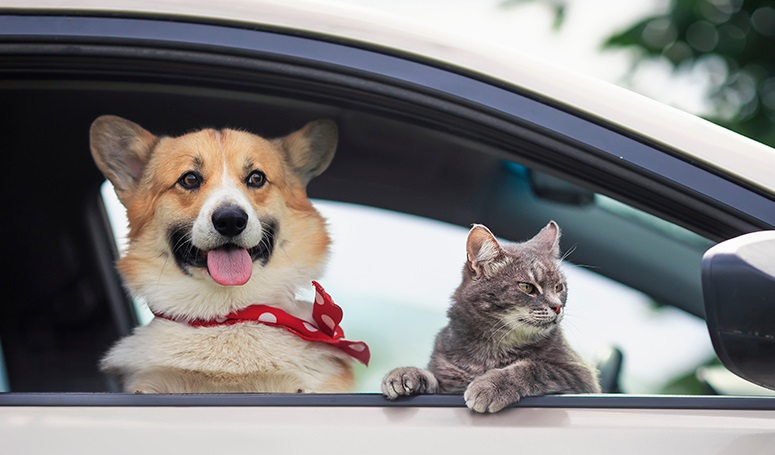11th April, 2023
Pets really do make the best companions, so it’s no surprise that many of us love to bring them along with us on our road trips - especially now that warmer weather is on the way and we’re planning that long-awaited staycation. So, we’ve rounded up some helpful tips on how to properly look after your pet whilst you’re on the road.
First and foremost, it’s important to make sure that your pet is properly secured whilst in the car. As stated in rule 57 of the Highway Code, dogs or other animals must be suitably restrained so that they can’t distract the driver, or injure you or themselves if you have to stop suddenly.
It’s incredibly easy for a driver to become distracted by a pet on the loose, whether that’s by you having to give commands or by the pet getting in the way of things like the steering wheel and pedals. This not only puts your pet, you and any other passengers in danger, but it also puts all other road users in danger too.
Not to mention that becoming distracted by your pet could lead to you receiving a serious motoring conviction, such as driving without due care and attention or, even worse, dangerous driving.
If your pet is making a lot of noise in the car, such as loudly barking, then it can also become difficult to have awareness of what’s going on around you, like listening out for the siren of an ambulance coming towards you.
Not only is it a danger to yourself and others on the road to have your pet unrestrained, it’s also a big risk to your four-legged friend themselves, as they’re far more likely to be seriously hurt in the unfortunate event of a motoring accident. Plus, letting your pet hang their heads out of the window, however cute it may be, can result in dirt or debris from the road hurting their eyes, nose or mouth. You wouldn’t drive off without making sure your human passengers have their seatbelts on, so why should your pet be left unsecured and at risk?
There are plenty of ways to suitably restrain your pet, such as a seat belt harness, pet carrier, dog cage or dog guard. A cage, for example, would be well suited for dogs who are currently being, or have been, crate trained at home, and a pet carrier could be suitable for smaller pets. When deciding on which method to go for, consider factors such as what type of pet you have, their size and what they’re already used to.
Animals often become anxious when it comes to getting them in the car, especially if they’re not used to them, so it’s a good idea to start off with shorter journeys to ease your pet into the idea of being confined to a smaller space. An anxious pet can quickly become a restless and fidgety pet, so make sure to remove anything that could become a strangulation hazard, such as collars and leashes.
If you’re travelling with your dog then take them on a long walk before setting off so that they can burn off as much energy as possible and therefore will be more likely to relax or sleep whilst in the car – this is especially worthwhile if you’ve got a puppy or a breed that is known for having lots of energy.
Factor in extra time on your journey to make regular toilet and exercise breaks. If it won’t be possible to make that many stops then travel with plenty of cleaning supplies and waterproof sheets in case any accidents do happen. With that being said, make sure that you aren’t restricting your pet’s access to water just to avoid an accident, it’s important to keep them hydrated for their own comfort and to prevent car sickness.
Speaking of sickness, avoid feeding your pet within 2 to 3 hours of the car journey so that they are less likely to get sick. If they do become sick then let fresh air in so that the car isn’t too hot and stuffy for them.
There are also things to consider that won’t necessarily affect your pets comfort but will most certainly safe you a potential headache! If you are travelling outside of the UK with your pet, then be sure to check the requirements of the country that you’re travelling to and make sure that you have all of the required documentation for your pet. Also keep in mind that, by law, your dog must be microchipped by the time it reaches 8 weeks old otherwise you could face a fine of up to £500.
With plenty of careful planning and preparation, it’s easy to have a smooth car journey with your pet and make memories to last a lifetime.
Written by: Shannan Errington
*Please note that the above information has been gathered through secondary research. The information provided is not based on our opinion. You should seek further guidance and information before making an informed decision.
Sources:
https://www.gov.uk/guidance/the-highway-code/rules-about-animals-47-to-58
https://www.theaa.com/driving-advice/safety/pets-in-the-car
https://www.gov.uk/get-your-dog-microchipped

